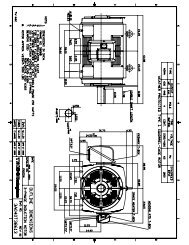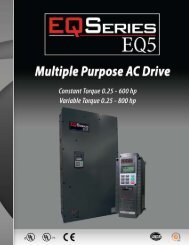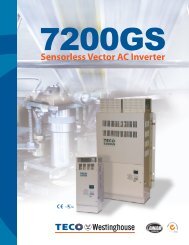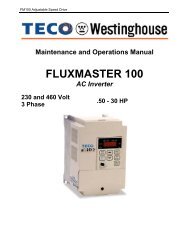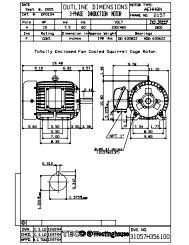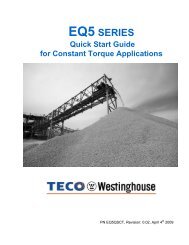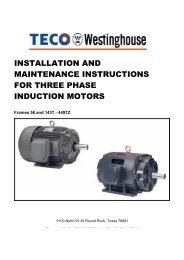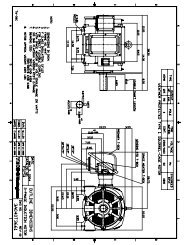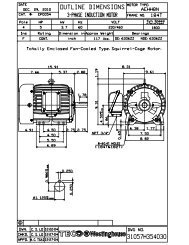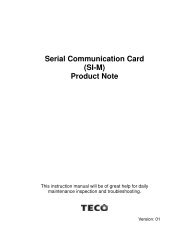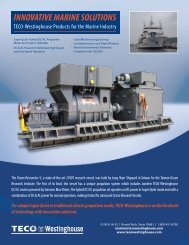EQ7 Series Instruction Manual - TECO-Westinghouse Motor Company
EQ7 Series Instruction Manual - TECO-Westinghouse Motor Company
EQ7 Series Instruction Manual - TECO-Westinghouse Motor Company
You also want an ePaper? Increase the reach of your titles
YUMPU automatically turns print PDFs into web optimized ePapers that Google loves.
[ 10 ] <strong>Motor</strong> protection (PTC/NTC thermistor)<br />
Problem Temperature of the motor has risen abnormally.<br />
Possible Causes<br />
(1) The temperature around the<br />
motor exceeded the motor's<br />
specification range.<br />
(2) Cooling system for the motor<br />
defective.<br />
What to Check and Suggested Measures<br />
Measure the temperature around the motor.<br />
Lower the temperature.<br />
Check if the cooling system of the motor is operating normally.<br />
Repair or replace the cooling system of the motor.<br />
(3) Overload. Measure the output current.<br />
Reduce the load (e.g. Use the heat sink overheat early warning (E01 through<br />
E07) or the overload early warning (E34) and reduce the load before the<br />
overload protection is activated.). (In winter, the load tends to increase.)<br />
Lower the temperature around the motor.<br />
Increase the motor sound (Carrier frequency) (F26).<br />
(4) The activation level (H27) of<br />
the PTC thermistor for motor<br />
overheat protection was set<br />
inadequately.<br />
(5) Settings for the PTC/NTC<br />
thermistor are improper.<br />
(6) Excessive torque boost<br />
specified. (F09*)<br />
(7) The V/f pattern did not<br />
match the motor.<br />
(8) Incorrect setting of function<br />
code data.<br />
Check the PTC thermistor specifications and recalculate the detection voltage.<br />
Modify the data of function code H27.<br />
Check the setting of the thermistor mode selection (H26) and the slider position<br />
of terminal [C1] property switch SW5.<br />
Change the H26 data in accordance with the thermistor used and set the<br />
SW5 to the PTC/NTC position.<br />
Check whether decreasing the torque boost (F09*) does not stall the motor.<br />
If no stall occurs, decrease the F09* data.<br />
Check if the base frequency (F04*) and the rated voltage at base frequency<br />
(F05*) match the values on the motor's nameplate.<br />
Match the function code data with the values on the motor's nameplate.<br />
Although no PTC/NTC thermistor is used, the thermistor mode is enabled (H26).<br />
Set the H26 data to "0" (Disable).<br />
[ 11 ] Braking resistor overheated<br />
Problem The electronic thermal protection for the braking resistor has been activated.<br />
Possible Causes<br />
What to Check and Suggested Measures<br />
(1) Braking load is too heavy. Reconsider the relationship between the braking load estimated and the real<br />
load.<br />
Lower the real braking load.<br />
Review the selection of the braking resistor and increase the braking<br />
capability (Modification of related function code data (F50, F51, and F52) is<br />
also required.)<br />
(2) Specified deceleration time<br />
is too short.<br />
(3) Incorrect setting of function<br />
code data F50, F51, and<br />
F52.<br />
Recalculate the deceleration torque and time needed for the load currently<br />
applied, based on a moment of inertia for the load and the deceleration time.<br />
Increase the deceleration time (F08, E11, E13, E15, and H56).<br />
Review the selection of the braking resistor and increase the braking<br />
capability. (Modification of related function code data (F50, F51, and F52) is<br />
also required.)<br />
Recheck the specifications of the braking resistor.<br />
Review data of function codes F50, F51, and F52, then modify them.<br />
Note: The inverter issues an overheat alarm of the braking resistor by monitoring the magnitude of the braking load, not<br />
by measuring its surface temperature.<br />
When the braking resistor is frequently used so as to exceed the settings made by function codes F50, F51, and F52,<br />
therefore, the inverter issues an overheat alarm even if the surface temperature of the braking resistor does not rise. To<br />
squeeze out full performance of the braking resistor, configure function codes F50, F51, and F52 while actually<br />
measuring the surface temperature of the braking resistor.<br />
10-16




